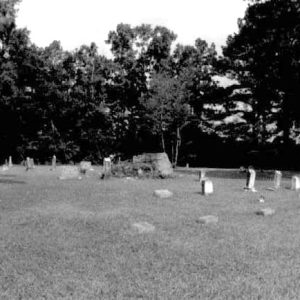calsfoundation@cals.org
Ephesus Cemetery
The Ephesus Cemetery is located north of Emmet (Nevada and Hempstead counties). The cemetery is next to the original location of the Ephesus Primitive Baptist Church, established in 1860. The oldest dated burial is from November 1876, and the cemetery was added to the National Register of Historic Places on January 22, 2009.
Early settlers to the area began arriving in the 1850s. A post office in the Emmet area was established in 1871, and the town was platted in 1873. The Ephesus Primitive Baptist Church was one of the earliest churches in the area. A school also operated at the site at the time of the founding of the church, according to the deed dated January 3, 1860. The original building was demolished and replaced in the 1940s. The 1940s church building, which is privately owned and in disrepair, is not part of the National Register–listed property and is no longer active.
The cemetery contains seventy-four marked historic graves. Twenty-seven unmarked graves are also located in the cemetery, along with six marked, non-historic graves. The most recent burial occurred in 2012. North of the former church, the cemetery is located along U.S. Highway 67 north of Emmet. A modern chain-link fence surrounds the cemetery on three sides, with the west side lined with trees and bushes. The cemetery does not contain any ironwork or original fencing.
While it is possible that some of the unmarked graves predate the earliest marked graves, the first recorded burial was of the infant daughter of J. L. and Elizabeth McGough on November 6, 1876. Only one dated grave was placed in the 1870s. From the 1880s to the 1950s, the total number of marked and dated interments averaged eight per decade. Many of the graves included in the cemetery belong to early settlers to the area.
Most of the markers in the cemetery face east and are a mixture of simple homemade stones along with more elaborate commercially produced markers. Numerous decorative motifs appear on markers, including arches, ivy, doves, open Bibles, and the Gates of Heaven. Most of the markers are made from either granite or marble. The markers are designed in a number of styles, including pulpit marker, plaque marker, and lawn style. Several have been broken, and other damage has been caused by erosion. A brick vault rests near the center of the cemetery. Covered in concrete, the vault does not contain the name of the person interred but does contain an inscription with the name of the builder. The cemetery is not divided into formal plots, although families are buried in small groups together.
A group continues to maintain the cemetery, although it is unlikely that many graves will be added in the future. It continues to be a good representation of late-nineteenth-century cemeteries in southwestern Arkansas.
For additional information:
“Ephesus Cemetery.” National Register for Historic Places registration form. On file at Arkansas Historic Preservation Office, Little Rock, Arkansas. Online at http://www.arkansaspreservation.com/National-Register-Listings/PDF/NE0166.nr.pdf (accessed January 24, 2020).
Nevada County Depot and Museum. http://www.depotmuseum.org (accessed January 24, 2020).
David Sesser
Henderson State University
 Civil War through Reconstruction, 1861 through 1874
Civil War through Reconstruction, 1861 through 1874 Historic Preservation
Historic Preservation Ephesus Cemetery
Ephesus Cemetery  Ephesus Cemetery
Ephesus Cemetery 




Comments
No comments on this entry yet.